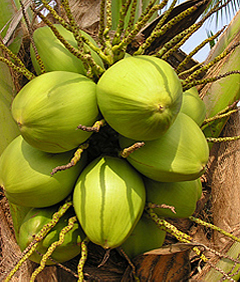Coconut Planting Seasons and Climate
Planting Seasons
Tamil Nadu:
June - July, December – January
The planting can also be taken up in other seasons wherever irrigation and drainage facilities are available.
Kerala: Planting the seedlings during May, with the onset of pre-monsoon rains is ideal. Under assured irrigation, planting can be done during April also. In low-lying areas, plant the seedlings in September after the cessation of heavy rains.
Karnataka: Planting the seedlings during May – June, is ideal for good cultivation.
Climate
Latitude and Altitude: Coconut is a tropical crop and grows well a hot climate.
Tamil Nadu and Kerala - The coconut thrives well within 23 degrees of the equator (Between 200N and 200S latitudes) and an altitude of upto 600 m above Mean Sea Level. However, it is being grown upto 900 m above mean sea level in some places.
Karnataka - The coconut palm thrives well within 230N and 230S latitude. Even though it is grown as far as 27° N and 27° S, those palms put on good vegetative growth but exhibit poor nut yield and hence not grown in a commercial scale beyond 23° N and 23° S. Normally an altitude of 600 m appears to be the limit for commercial coconut cultivation.
Temperature: Temperature is an important weather factor that has great influence on the growth and productivity of the palm. The palm prefers less diurnal variation between day and night temperatures and does not tolerate extremes of temperature. The temperature should be from 20 ° to 32°C, a mean annual temperature of 270C is best for vigorous growth and good yield. The yield reduces when mean temperature falls below 210C. High temperature may cause the developing inflorescences to dry up, and limit production during those months in the year.
Rainfall: A total of 1000 mm is sufficient, if it is evenly distributed throughout the year. However, rainfall upto 3000 mm is also ideal for coconut cultivation if the distribution varies to certain extent and drainage of the soil is good. (Kerala: A well distributed rainfall of 1300 – 2300 mm per annum is preferred). Prolonged dry spell requires irrigation. Irrigation during summer months has positive correlation on the nut yield. Staggered rainfall during different periods of the year is more important than the total rainfall during any particular period. The rainfall received during any particular period is relevant to the texture and depth of the soil type. A water table that is too high and remains stagnant over and long period is definitely harmful to the palm. Even in dry interior area with a low annual rainfall of 500 to 800 mm, it is possible to grow coconut where sub-soil moisture is adequate at the depression of rolling lands and near valleys or adjacent to tanks.
Humidity and Wind: The optimum relative humidity is 80 – 85 per cent (Karnataka – the monthly means of relative humidity should not fall below 60%). High relative humidity increases the incidence of pest and disease and reduces nutrient uptake. In tall palms, wind plays an important part in the dispersal of pollen and the fertilization of flowers; increase of water, leading to its greater absorption. Windy atmosphere increases transpiration rates and helps in uptake of nutrients from soil. The coconut palm can tolerate high winds but not cyclones. Cyclones will uproot the palms or twist the crowns. Conditions near the sea are ideal but palms come up well even hundreds of kilometer as in the inland away from the sea. The palms near sea benefit from less diurnal fluctuation in the temperature and high relative humidity. Moisture availability is not restricted near the sea.
Sunshine: The palm requires plenty of sunlight and does not grow well under shade or in cloudy conditions. Cloudiness arrests the rate of transpiration.
Coconut is grown in different soil types such as laterite, coastal sandy, alluvial, and also in reclaimed soils of the marshy lowlands. It tolerates salinity and a wide range of pH (from 5.0-8.0).



